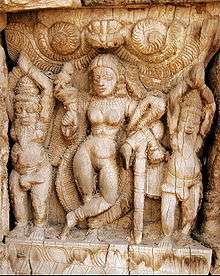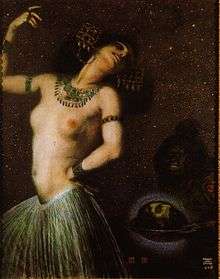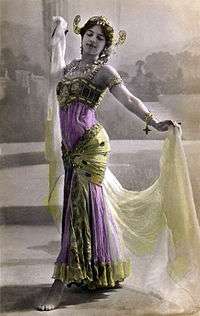Femme fatale
A femme fatale (/ˌfæm fəˈtɑːl/ or /ˌfɛm fəˈtɑːl/; French: [fam fatal]) is a stock character of a mysterious and seductive woman whose charms ensnare her lovers, often leading them into compromising, dangerous, and deadly situations. She is an archetype of literature and art. Her ability to entrance and hypnotise her victim with a spell was in the earliest stories seen as being literally supernatural; hence, the femme fatale today is still often described as having a power akin to an enchantress, seductress, vampire, witch, or demon, having power over men.
The phrase is French for "fatal woman". A femme fatale tries to achieve her hidden purpose by using feminine wiles such as beauty, charm, and sexual allure. In some situations, she uses lies or coercion rather than charm. She may also make use of some subduing weapon such as sleeping gas, a modern analog of magical powers in older tales. She may also be (or imply that she is) a victim, caught in a situation from which she cannot escape; The Lady from Shanghai (a 1947 film noir) is one such example.
One of the most common traits of the femme fatale include promiscuity and the "rejection of motherhood," seen as "one of her most threatening qualities since by denying his immortality and his posterity it leads to the ultimate destruction of the male."[1] Femmes fatale are typically villainous, or at least morally ambiguous, and always associated with a sense of mystification and unease.[2]
History
Ancient archetypes

The femme fatale archetype exists in the culture, folklore and myth of many cultures.[3] Ancient mythical or legendary examples include Mohini, Lilith, the Sirens, the Sphinx, Scylla, Aphrodite, Circe, Medea, Clytemnestra, Lesbia, Helen of Troy and Visha Kanyas. Historical examples from Classical times include Cleopatra and Messalina, as well as the Biblical figures Delilah, Jezebel and Salome.[4] An example from Chinese literature and traditional history is Daji.
Early Western culture to the 19th century

The femme fatale was a common figure in the European Middle Ages, often portraying the dangers of unbridled female sexuality. The pre-medieval inherited Biblical figure of Eve offers an example, as does the wicked, seductive enchantress typified in Morgan le Fay. The Queen of the Night in Mozart's The Magic Flute shows her more muted presence during the Age of Enlightenment[5]
The femme fatale flourished in the Romantic period in the works of John Keats, notably "La Belle Dame sans Merci" and "Lamia". Along with them, there rose the gothic novel, The Monk featuring Matilda, a very powerful femme fatale. This led to her appearing in the work of Edgar Allan Poe, and as the vampire, notably in Carmilla and Brides of Dracula. The Monk was greatly admired by the Marquis de Sade, for whom the femme fatale symbolised not evil, but all the best qualities of Women; his novel Juliette is perhaps the earliest wherein the femme fatale triumphs. Pre-Raphaelite painters frequently used the classic personifications of the femme fatale as a subject.
In the Western culture of the late nineteenth and early twentieth centuries, the femme fatale became a more fashionable trope,[6] and she is found in the paintings of the artists Edvard Munch, Gustav Klimt, Franz von Stuck and Gustave Moreau. The novel À rebours by Joris-Karl Huysmans includes these fevered imaginings about an image of Salome in a Moreau painting:[7]
No longer was she merely the dancing-girl who extorts a cry of lust and concupiscence from an old man by the lascivious contortions of her body; who breaks the will, masters the mind of a King by the spectacle of her quivering bosoms, heaving belly and tossing thighs; she was now revealed in a sense as the symbolic incarnation of world-old Vice, the goddess of immortal Hysteria, the Curse of Beauty supreme above all other beauties by the cataleptic spasm that stirs her flesh and steels her muscles, – a monstrous Beast of the Apocalypse, indifferent, irresponsible, insensible, poisoning.
She also is seen as a prominent figure in late nineteenth and twentieth century opera, appearing in Richard Wagner's Parsifal (Kundry), George Bizet's "Carmen", Camille Saint-Saëns' "Samson et Delilah" and Alban Berg's "Lulu" (based on the plays "Erdgeist" and "Die Büchse der Pandora" by Frank Wedekind).
In fin-de-siècle decadence, Oscar Wilde reinvented the femme fatale in the play Salome: she manipulates her lust-crazed uncle, King Herod, with her enticing Dance of the Seven Veils (Wilde's invention) to agree to her imperious demand: "bring me the head of John the Baptist". Later, Salome was the subject of an opera by Strauss, and was popularized on stage, screen, and peep-show booth in countless reincarnations.[8]
Another enduring icon of glamour, seduction, and moral turpitude is Margaretha Geertruida Zelle, 1876–1917. While working as an exotic dancer, she took the stage name Mata Hari. Although she may have been innocent, she was accused of German espionage and was put to death by a French firing squad. After her death she became the subject of many sensational films and books.
Other considerably famous femmes fatales are Isabella of France, Hedda Gabler of Kristiania (now Oslo), Marie Antoinette of Austria, and, most famously, Lucrezia Borgia.
20th-century film and theatre

One traditional view portrays the femme fatale as a sexual vampire; her charms leech the virility and independence of lovers, leaving them shells of themselves. Rudyard Kipling took inspiration from a vampire painted by Philip Burne-Jones, an image typical of the era in 1897, to write his poem "The Vampire". The poem inspired the 1913 eponymous film by Robert Vignola, sometimes cited as the first "vamp" movie.[9] Like much of Kipling's verse it became very popular, and its refrain: "A fool there was...", describing a seduced man, became the title of the popular 1915 film A Fool There Was that made Theda Bara a star. The poem was used in the publicity for the film. On this account, in the American slang of the era the femme fatale was called a vamp, short for vampire.[10]
From the American film-audience perspective, the femme fatale often appeared foreign, usually either of indeterminate Eastern European or Asian ancestry. She was the sexual counterpart to wholesome actresses such as Lillian Gish and Mary Pickford. Notable silent-cinema vamps included Theda Bara, Helen Gardner, Louise Glaum, Valeska Suratt, Musidora, Virginia Pearson, Olga Petrova, Rosemary Theby, Nita Naldi, Pola Negri, Estelle Taylor, Jetta Goudal, and, in early appearances, Myrna Loy.
During the film-noir era of the 1940s and early-1950s, the femme fatale flourished in American cinema. Examples include Brigid O'Shaughnessy, portrayed by Mary Astor, who murders Sam Spade's partner in The Maltese Falcon (1941); Gene Tierney as Ellen Brent Harland in Leave Her to Heaven (1945), and the cabaret singer portrayed by Rita Hayworth in Gilda (1946),[11] narcissistic wives who manipulate their husbands; Phyllis Dietrichson (Barbara Stanwyck) in Double Indemnity (1944), Ava Gardner in The Killers and Cora (Lana Turner) in The Postman Always Rings Twice, based on novels by Ernest Hemingway and James M. Cain respectively, manipulate men into killing their husbands.[11] In the Hitchcock film The Paradine Case (1947), Alida Valli's character causes the deaths of two men and the near destruction of another. Another frequently cited example is the character Jane played by Lizabeth Scott in Too Late for Tears (1949); during her quest to keep some dirty money from its rightful recipient and her husband, she uses poison, lies, sexual teasing and a gun to keep men wrapped around her finger. Jane Greer remains notable as a murderous femme fatale using her wiles on Robert Mitchum in Out of the Past (1949). In Hitchcock's 1940 film and Daphne du Maurier's 1938 novel Rebecca, the eponymous femme fatale completely dominates the plot, even though she is already dead and we never see an image of her.
The femme fatale has carried on to the present day, in films such as Body Heat (1981) and Prizzi's Honor (1985) – both with Kathleen Turner, Blade Runner (1982) with Sean Young, Blue Velvet (1986) with Isabella Rossellini as the seductive torch singer Dorthy Vallens, Basic Instinct (1992) with Sharon Stone, Damage (1992) with Juliette Binoche, The Last Seduction (1994) with Linda Fiorentino, To Die For (1995) with Nicole Kidman, Lost Highway (1997) with Patricia Arquette, Devil in the Flesh (1998) and Jawbreaker (1999), both with Rose McGowan, Original Sin (2001) with Angelina Jolie, Femme Fatale (2002) with Rebecca Romijn, and Jennifer's Body (2009), with Megan Fox. In 2013, Tania Raymonde played the title role in Jodi Arias: Dirty Little Secret. In 2014, Eva Green portrays a femme fatale character in Sin City: A Dame to Kill For, and Rosamund Pike staring as Amy Elliott Dunne in the psychological thriller Gone Girl .
Academy Award-winning actress Marion Cotillard has frequently played femmes fatales, in such films as A Private Affair (2002), A Very Long Engagement, The Black Box, Inception, Midnight in Paris, The Dark Knight Rises and Macbeth. Nicole Kidman has also played a few femmes fatales in films as To Die For, The Paperboy and Moulin Rouge!.
The archetype is also abundantly found in American television. One of the most famous femmes fatales of American television is Sherilyn Fenn's Audrey Horne of the David Lynch cult series Twin Peaks. In the Netflix TV series, Orange Is the New Black, actress Laura Prepon plays Alex Vause, a modern femme fatale, leading both men and women to their destruction.
Use in criminal trials
The term has been used in connection with highly publicised criminal trials, such as the trials of Jodi Arias[12][13] and Amanda Knox.[14]
See also
References
- ↑ Walter, Susan (2015). "Images of the Femme Fatale in two Short Stories by Emilia Pardo Bazán". Romance Notes. Retrieved December 8, 2015.
- ↑ Mary Ann Doane, Femme Fatales (1991) pp. 1–2
- ↑ Mario Praz, The Romantic Agony, ch. IV, p. 199: La Belle Dame sans Merci (The Beautiful Lady without Mercy). London/New York, 1933–1951–1970 (Oxford University Press).
- ↑ Mario Praz (1970) The Romantic Agony. Oxford University Press: 199, 213–216, 222, 250, 258, 259, 272, 277, 282, 377
- ↑ C. G. Jung ed, Man and his Symbols (1978) p. 187
- ↑ Jill Scott, Electra after Freud (2005) p. 66
- ↑ Huysmans À rebours – Toni Bentley (2002) Sisters of Salome: 24
- ↑ Toni Bentley (2002) Sisters of Salome
- ↑ John T. Soister, American Silent Horror, Science Fiction and Fantasy Feature Films, 1913-1929, McFarland, 2012, p.41
- ↑ Per the Oxford English Dictionary, vamp is originally English, used first by G. K. Chesterton, but popularized in the American silent film The Vamp, starring Enid Bennett
- 1 2 Johnston, Sheila (27 February 2009). "Whatever happened to the femme fatale?". The Independent. Archived from the original on February 28, 2009. Retrieved 27 February 2009.
- ↑ Ortiz, Erik. "Jodi Arias: Femme fatale or woman of faith? Jurors hear conflicting persona in murder trial as prosecutors play phone calls of Arias lying".
- ↑ "Jodi Arias Trial Update: Lawyer Reveals Femme Fatale Was Terrified During Sentencing". Retrieved 2015-04-30.
- ↑ "Amanda Knox is no femme fatale, defence lawyer says". BBC News. Retrieved 2015-04-30.
Further reading
- Giuseppe Scaraffia (2009) Femme fatale. ISBN 978-88-389-0396-0.
- Toni Bentley (2002) Sisters of Salome. Salome considered as an archetype of female desire and transgression and as the ultimate femme fatale.
- Bram Dijkstra (1986) Idols of Perversity: Fantasies of Feminine Evil in Fin-De-Siecle Culture, (1986) ISBN 0-19-505652-3. Discusses the Femme fatale-stereotype.
- Bram Dijkstra (1996) Evil Sisters: The Threat of Female Sexuality in Twentieth-Century Culture, (1996) ISBN 0-8050-5549-5
- Elizabeth K. Mix Evil By Design: The Creation and Marketing of the Femme Fatale, ISBN 978-0-252-07323-6. Discusses the origin of the Femme fatale in 19th century French popular culture.
- Mario Praz (1930) The Romantic Agony. See chapters four, 'La Belle Dame Sans Merci', and five, 'Byzantium'.

